1993 CADILLAC FLEETWOOD headlights
[x] Cancel search: headlightsPage 91 of 386

Downloaded from www.Manualslib.com manuals search engine r The alarm won’t stop if you try to unlock a door any other way.
How to Test The Alarm
Roll down your window and lock your vehicle using the power door
Reach in and unlock the door using the manual lock, and open the
lock.
door. The horn will sound and your headlights will flash.
If the alarm does not sound when it should, check to see
if the horn
- works. The horn fuse may be blown. To replace the fuse, see “Fuses and
Circuit Breakers” in the Index.
To reduce the possibility of theft, always arm the theft deterrent system
- when leaving your vehicle.
PASS-KEY IIm
- Your vehicle is equipped with the PASS-Key I1 TM (Personalized
- different to arm or disarm the system. It works when you insert or remove
Automotive Security System)
theft deterrent system. PASS-Key
I1 is a
passive theft deterrent system. This means you don’t have to do anything
the
key from the ignition. PASS-Key TM uses a resistor pellet in the
ignition key that matches a decoder in your vehicle.
key, it shuts down the vehicle’s starter and fuel systems. For about three
minutes, the starter won’t work and fuel won’t go to the engine. If
__ someone tries to start your vehicle again or uses another key during this
time, the vehicle will not start. This discourages someone from randomly
trying different keys with different resistor pellets in an attempt to make
a
match.
The ignition key must be clean and dry before it’s inserted in the ignition
or the engine may not start.
If the engine does not start and and the
the ignition off.
Clean and dry the key. Wait about three minutes and try again. The
work, and the key appears to be clean and dry, wait about three minutes
and try the other ignition key. At this time, you may also want to check
- When the PASS-Key I1 TM system senses that someone is using the wrong
I_
- “PASS KEY FAULT” light comes on, the key may be dirty or wet. Turn
__ security light will remain on during this time. If the starter still won’t
77
Page 113 of 386
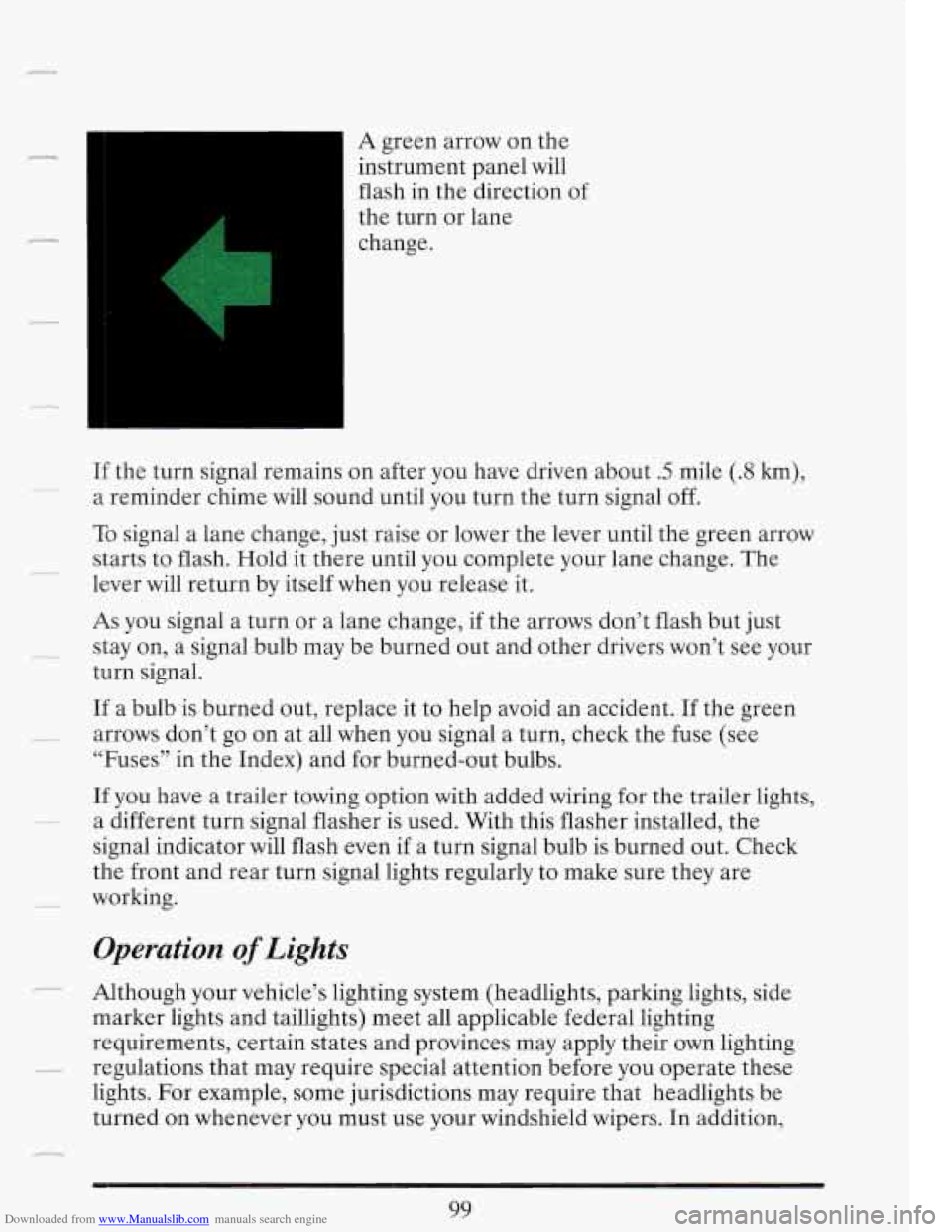
Downloaded from www.Manualslib.com manuals search engine A green arrow on the
instrument panel will
flash in the direction of
the turn or lane
change.
If the turn signal remains on after you have driven about .5 mile (.8 km),
a reminder chime will sound until you turn the turn signal off.
To signal a lane change, just raise or lower the lever until the green arrow
starts to flash. Hold it there until you complete your lane change. The
lever will return by itself when you release it.
AS you signal a turn or a lane change, if the arrows don’t flash but just
stay on, a signal bulb may be burned out and other drivers won’t see your
turn signal.
If a bulb is burned out, replace it to help avoid an accident. If the green
arrows don’t go on at all when you signal a turn, check the fuse (see
“Fuses” in the Index) and for burned-out bulbs.
If you have a trailer towing option with added wiring for the trailer lights,
a different turn signal flasher is used. With this flasher installed, the
signal indicator will flash even if a turn signal bulb is burned out. Check
the front and rear turn signal lights regularly to make sure they are
working.
Operation of Lights
Although your vehicle’s lighting system (headlights, parking lights, side
marker lights and taillights) meet all applicable federal lighting
requirements, certain states and provinces may apply their own lighting
regulations that may require special attention before you operate these
lights. For example, some jurisdictions may require that headlights be
turned on whenever you must use your windshield wipers. In addition,
Page 114 of 386
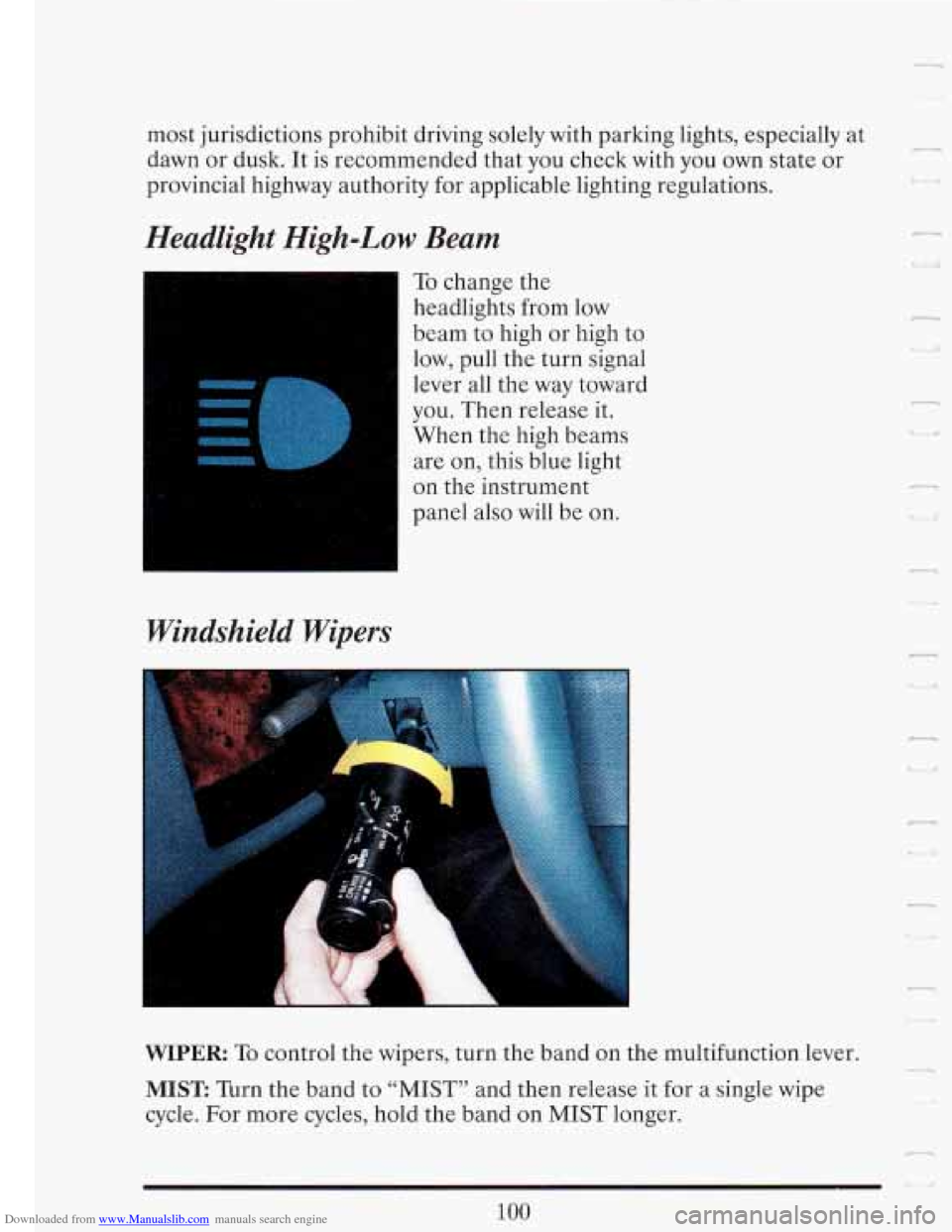
Downloaded from www.Manualslib.com manuals search engine most jurisdictions prohibit driving solely with parking lights, especially at
dawn or dusk. It is recommended that you check with
you own state or
provincial highway authority for applicable lighting regulations.
Headlight High-Low Beam
Windshield Wipers
To change the
headlights from low
beam to high or high to
low, pull the turn signal
lever all the way toward
you. Then release it.
When the high beams
are on, this blue light
on the instrument
panel also will be on.
WIPER To control the wipers, turn the band on the multifunction lever.
MIST: Turn the band to “MIST” and then release it for a single wipe
cycle. For more cycles, hold the band on MIST longer.
1 :I, U
100
Page 123 of 386
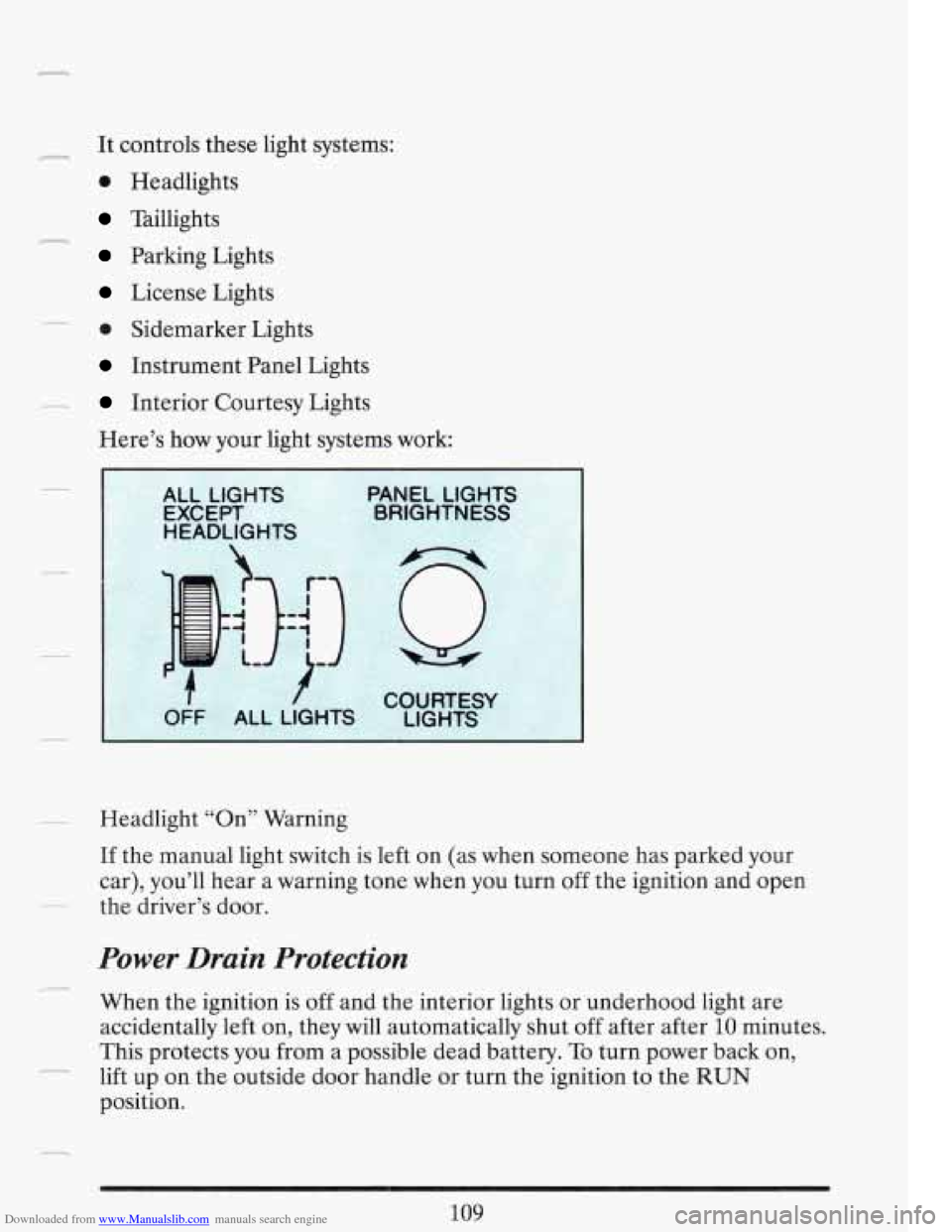
Downloaded from www.Manualslib.com manuals search engine .:- It controls these light systems:
e Headlights
Taillights
Parking Lights
License Lights
0 Sidemarker Lights
Instrument Panel Lights
g_
~
- Interior Courtesy Lights
Here’s how your light systems work:
Headlight “On” Warning
If the manual light switch is left on (as when someone has parked your
car), you’ll hear a warning tone when you turn
off the ignition and open
the driver’s door. -
Power Drain Protection
*-
When the ignition is off and the interior lights or underhood light are
accidentally left on, they will automatically shut off after after
10 minutes.
This protects you from a possible dead battery. To turn power back on,
lift up on the outside door handle or turn the ignition to the
RUN
position.
-
Page 126 of 386
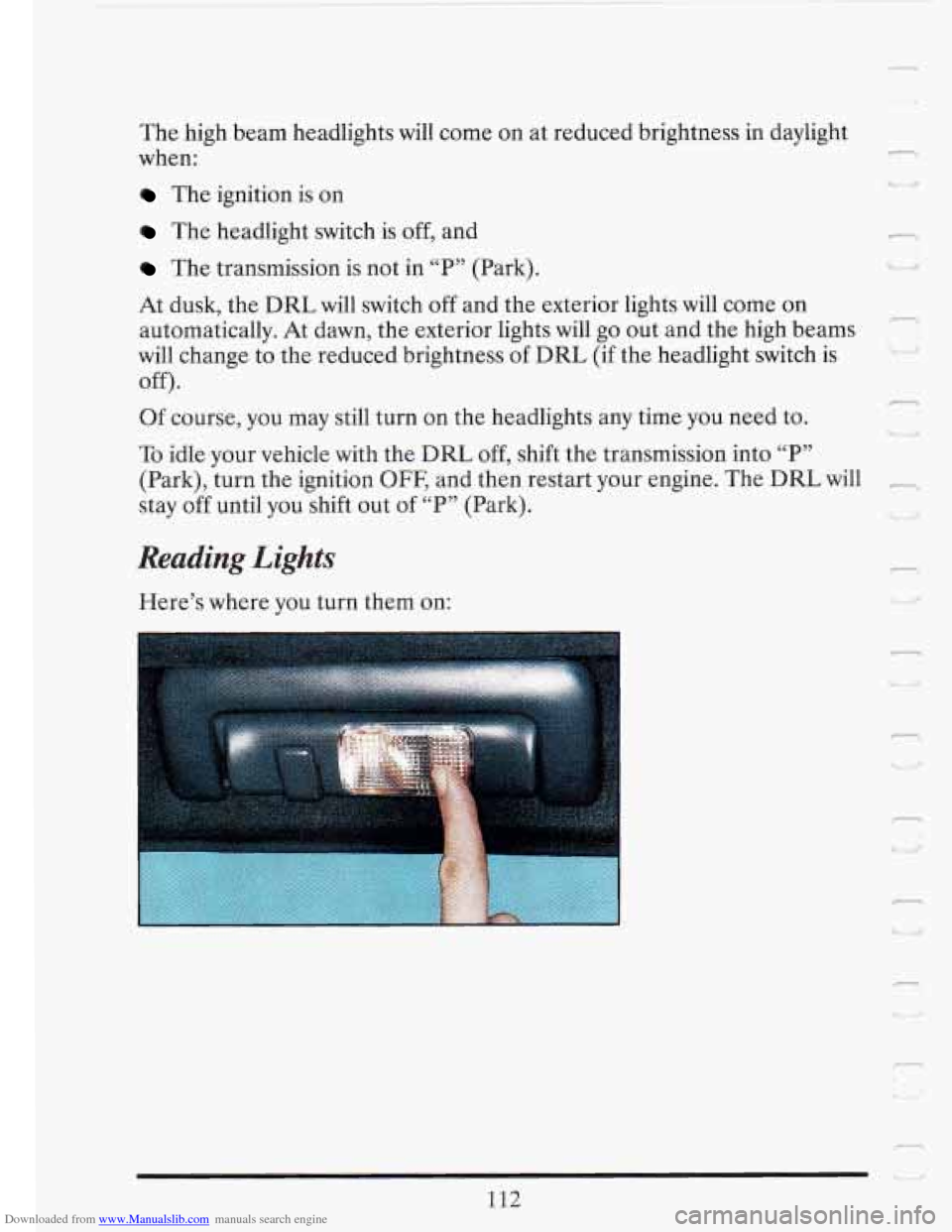
Downloaded from www.Manualslib.com manuals search engine The high beam headlights will come on at reduced brightness in daylight
when:
The ignition is on
The headlight switch is off, and
The transmission is not in “P” (Park).
At dusk, the DRL will switch off and the exterior lights
will come on
automatically. At dawn, the exterior lights will go out and the high beams
will change to the reduced brightness
of DRL (if the headlight switch is -
off).
Of course, you may still turn on the headlights any time you need to. W
To idle your vehicle with the DRL off, shift the transmission into “P”
(Park), turn the ignition
OFF, and then restart your engine. The DRL will -.
stay off until you shift out of “P” (Park). cd. 1
Reading Lights
Here’s where you turn them on:
n
c1 ’!
112
Page 129 of 386
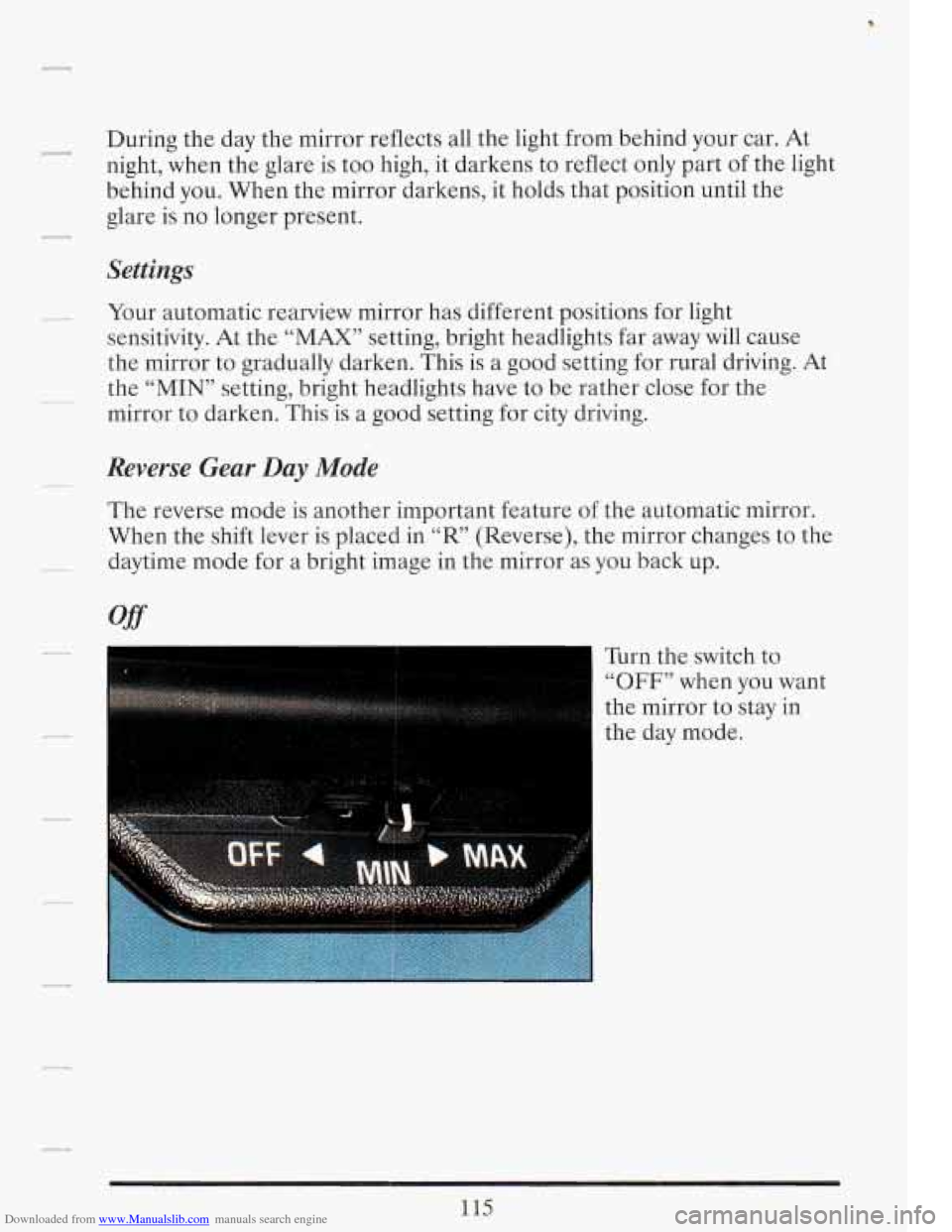
Downloaded from www.Manualslib.com manuals search engine - During the day the mirror reflects all the light from behind your car. At
night, when the glare is too high, it darkens to reflect only part
of the light
behind
you. When the mirror darkens, it holds that position until the
glare is no longer present.
R_
Settings
__ Your automatic rearview mirror has different positions for light
sensitivity. At the
“MAX” setting, bright headlights far away will cause
the mirror to gradually darken. This is a good setting for rural driving. At
mirror to darken. This
is a good setting for city driving.
-- the “MIN” setting, bright headlights have to be rather close for the
Reverse Gear Day Mode
The reverse mode is another important feature of the automatic mirror.
When the shift lever is placed in
“R’ (Reverse), the mirror changes to the
~
__ daytime mode for a bright image in the mirror as you back up.
off
Turn the switch to
“OFF” when you want
the mirror to stay in
the day mode.
115
Page 200 of 386
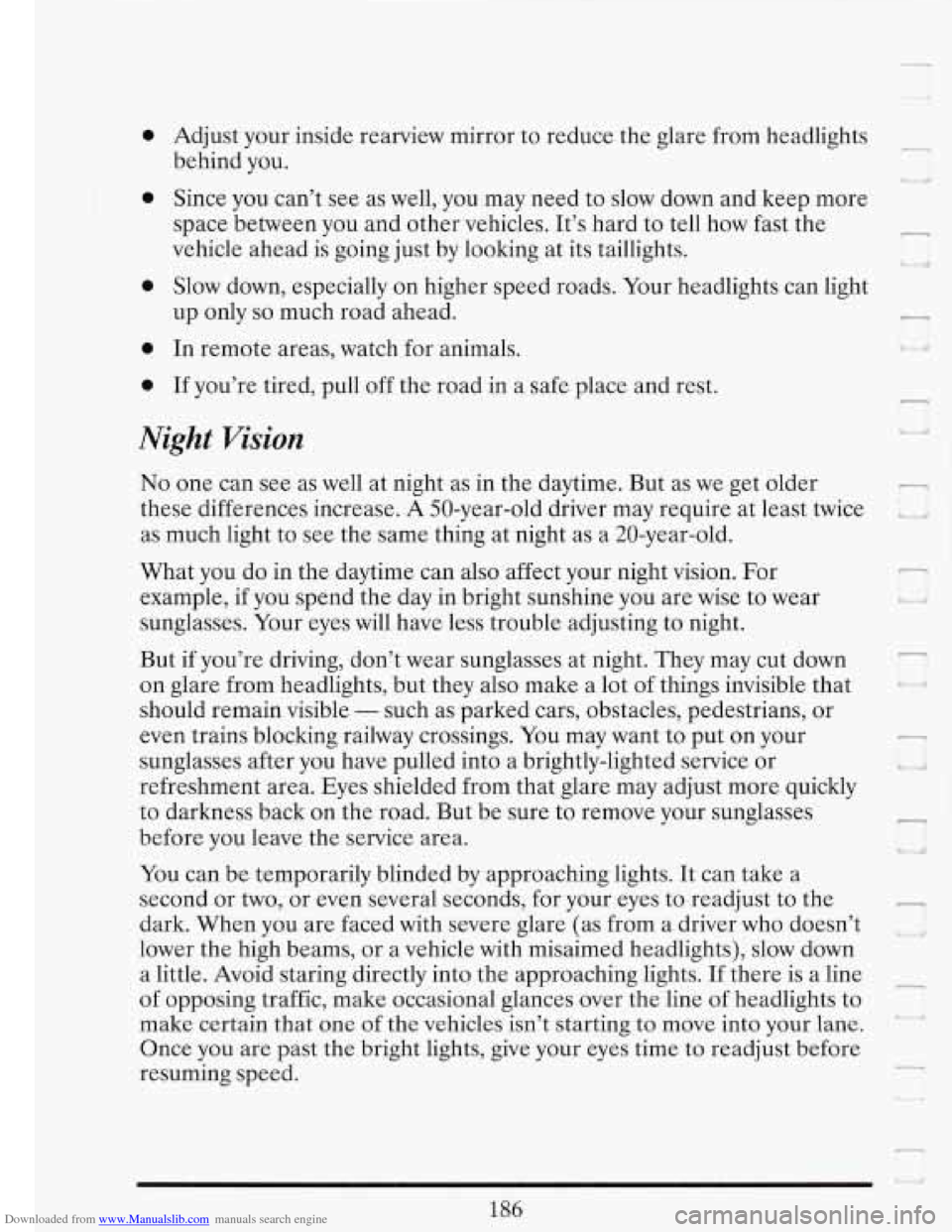
Downloaded from www.Manualslib.com manuals search engine 0
0
0
0
0
Adjust your inside rearview mirror to reduce the glare from headlights
behind you. -
Since you can’t see as well, you may need to slow down and keep more
space between you and other vehicles. It’s hard to tell how fast the
vehicle ahead is going just by looking at its taillights.
Slow down, especially on higher speed roads. Your headlights can light
up only
so much road ahead.
In remote areas, watch for animals.
If you’re tired, pull off the road in a safe place and rest.
Night Vision
f-I
i
No one can see as well at night as in the daytime. But as we get older -
these differences increase. A 50-year-old driver may require at least twice i,
as much light to see the same thing at night as a 20-year-old.
What you do in the daytime can also affect your night vision. For
example, if you spend the day in bright sunshine you are wise to wear
sunglasses. Your eyes will have less trouble adjusting to night.
But if you’re driving, don’t wear sunglasses at night. They may cut down
on glare from headlights, but they also make a lot of things invisible that
should remain visible
- such as parked cars, obstacles, pedestrians, or
even trains blocking railway crossings.
You may want to put on your
sunglasses after you have pulled into a brightly-lighted service or
refreshment area. Eyes shielded from that glare may adjust more quickly
to darkness back on the road. But be sure to remove your sunglasses
before you leave the service area.
I
3:
You can be temporarily blinded by approaching lights. It can take a
second or
two, or even several seconds, for your eyes to readjust to the r
dark. When you are faced with severe glare (as from a driver who doesn’t
lower the high beams, or a vehicle with misaimed headlights), slow down
a little. Avoid staring directly into the approaching lights.
If there is a line
of opposing traffic, make occasional glances over the line of headlights to
make certain that one of the vehicles isn’t starting to move into your lane.
Once you are past the bright lights, give your eyes time to readjust before
resuming speed.
I.-
-
i*
It 81
186
Page 201 of 386
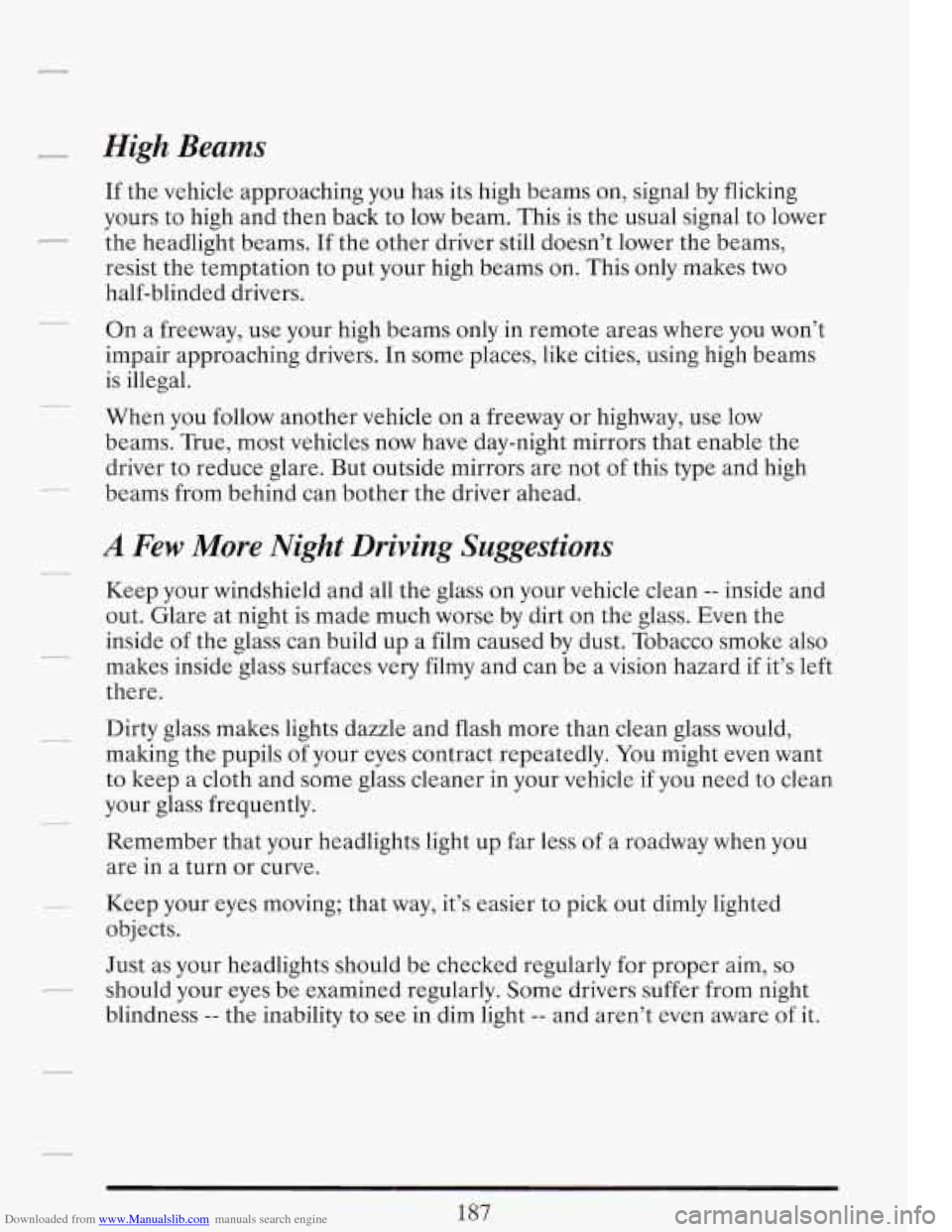
Downloaded from www.Manualslib.com manuals search engine r High Beams
If the vehicle approaching you has its high beams on, signal by flicking
yours to high and then back to low beam. This is the usual signal to lower
the headlight beams.
If the other driver still doesn’t lower the beams,
resist the temptation to put your high beams on. This only
makes two
half-blinded drivers.
- On a freeway, use your high beams only in remote areas where you won’t
impair approaching drivers. In some places, like cities, using high beams
is illegal.
When you follow another vehicle on a freeway or highway, use low
beams. True, most vehicles now have day-night mirrors that enable the
driver to reduce glare. But outside mirrors are not of this type and high
beams from behind can bother the driver ahead.
-
-
A Few More Night Driving Suggestions
-
Keep your windshield and all the glass on your vehicle clean -- inside and
out. Glare at night is made much worse by dirt on the glass. Even the
inside
of the glass can build up a film caused by dust. Tobacco smoke also
makes inside glass surfaces very filmy and can be a vision hazard
if it’s left
there. -
~ Dirty glass makes lights dazzle and flash more than clean glass would,
making the pupils
of your eyes contract repeatedly. You might even want
to keep a cloth and some glass cleaner in your vehicle if you need to clean
your glass frequently.
Remember that your headlights light up far less
of a roadway when you
are in a turn or curve.
-
_- Keep your eyes moving; that way, it’s easier to pick out dimly lighted
objects.
Just as your headlights should be checked regularly for proper aim, so
blindness
-- the inability to see in dim light -- and aren’t even aware of it.
- should your eyes be examined regularly. Some drivers suffer from night
187